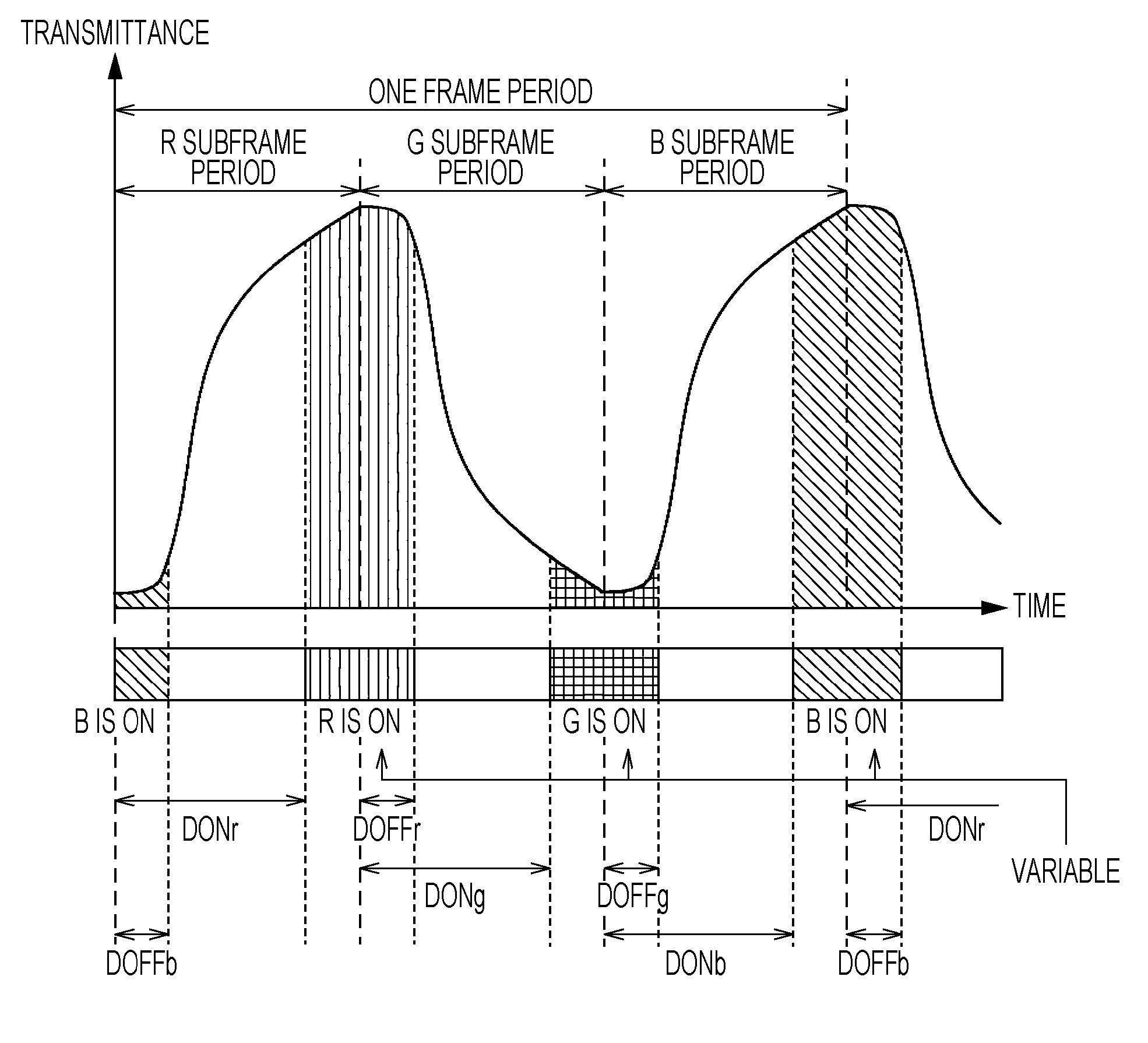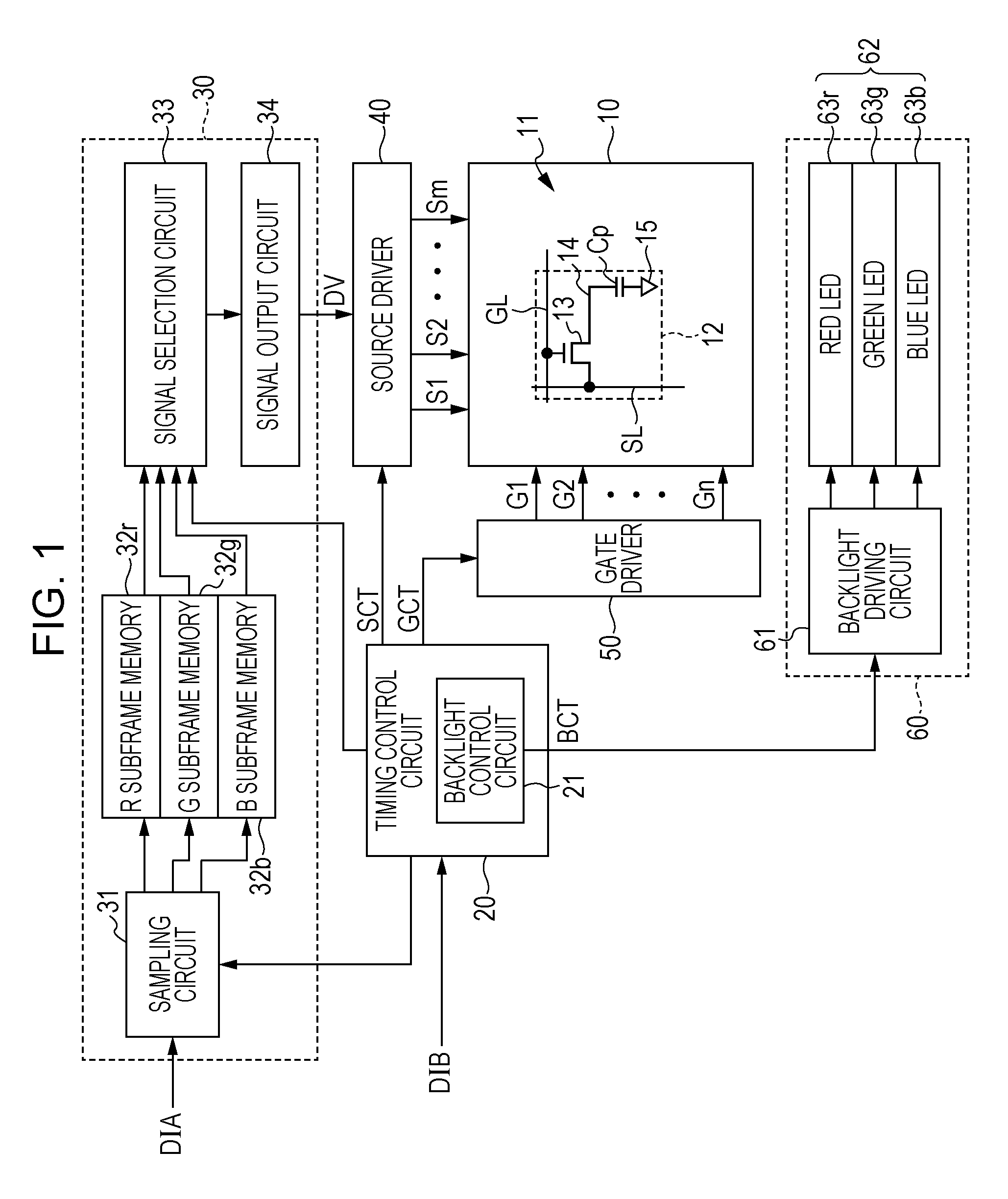Display device and method that divides one frame period into a plurality of subframe periods and that displays screens of different colors in accordance with the subframe periods
a display device and subframe period technology, applied in static indicating devices, non-linear optics, instruments, etc., can solve the problems of low light use efficiency of liquid crystal display devices adopting color filter methods, liquid crystal display devices adopting field sequential methods, and are attracting attention, so as to achieve desired luminance, reduce the effect of mixing colors and shorten the transmittan
- Summary
- Abstract
- Description
- Claims
- Application Information
AI Technical Summary
Benefits of technology
Problems solved by technology
Method used
Image
Examples
first embodiment
[0053]
[0054]
[0055]FIG. 1 is a block diagram illustrating the configuration of a liquid crystal display device adopting a field sequential method according to the first embodiment of the present invention. The liquid crystal display device according to this embodiment performs color display using a field sequential method in which each frame period is divided into three subframe periods. As illustrated in FIG. 1, this liquid crystal display device is configured by a liquid crystal display panel 10, a timing control circuit 20, a subframe image signal generation circuit 30, a source driver 40, a gate driver 50, and a backlight unit 60.
[0056]In the following description, for example, one frame period lasts 1 / 60 second, and each subframe period lasts 1 / 180 second. In addition, assume that a red component (R component), a green component (G component), and a blue component (B component) of an input image signal DIA input to the liquid crystal display device from the outside are each 8-bi...
second embodiment
[0078]
[0079]
[0080]FIG. 4 is a diagram illustrating the operation of a liquid crystal display device according to the second embodiment of the present invention. It is to be noted that this embodiment is the same as the first embodiment except for the configuration of the lengths of the on periods, and accordingly description of the same elements is omitted. In the first embodiment, the R on period, the G on period, and the B on period are uniformly configured in such a way as to have the same length and the lengths of these on periods are a fixed value. In contrast, whereas the R on period, the G on period, and the B on period in this embodiment are uniformly configured in such a way as to have the same length, the lengths of these on periods are variable. In addition, the driving current value of the LEDs 63 of each color may be changed as necessary in accordance with a change in the length of each on period.
[0081]A method for changing the length of each on period is not particular...
third embodiment
[0084]
[0085]
[0086]FIG. 5 is a diagram illustrating the operation of a liquid crystal display device according to the third embodiment of the present invention. It is to be noted that this embodiment is the same as the first or second embodiment except for the configuration of the lengths of the on periods, and accordingly description of the same elements is omitted. In the second embodiment, the R on period, the G on period, and the B on period are uniformly configured in such a way as to have the same length, and the lengths of these on periods are variable. In contrast, the R on period, the G on period, and the B on period in this embodiment can have different lengths. In addition, as in the second embodiment, the driving current value of the LEDs 63 of each color may be changed as necessary in accordance with a change in the length of each on period.
[0087]In the first and second embodiments, the lengths of the R on period, the G on period, and the B on period are the same, and, f...
PUM
| Property | Measurement | Unit |
|---|---|---|
| color temperature | aaaaa | aaaaa |
| colors | aaaaa | aaaaa |
| transmittance | aaaaa | aaaaa |
Abstract
Description
Claims
Application Information
 Login to View More
Login to View More - R&D
- Intellectual Property
- Life Sciences
- Materials
- Tech Scout
- Unparalleled Data Quality
- Higher Quality Content
- 60% Fewer Hallucinations
Browse by: Latest US Patents, China's latest patents, Technical Efficacy Thesaurus, Application Domain, Technology Topic, Popular Technical Reports.
© 2025 PatSnap. All rights reserved.Legal|Privacy policy|Modern Slavery Act Transparency Statement|Sitemap|About US| Contact US: help@patsnap.com



